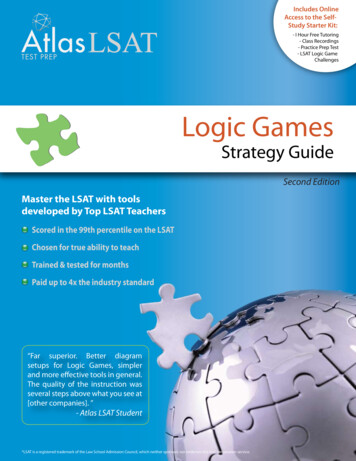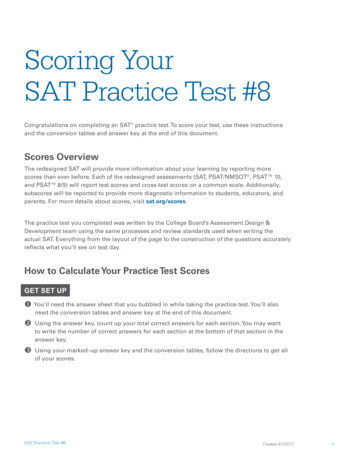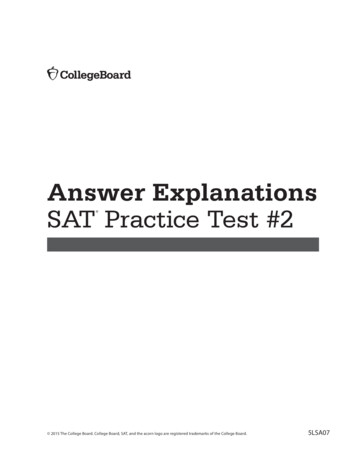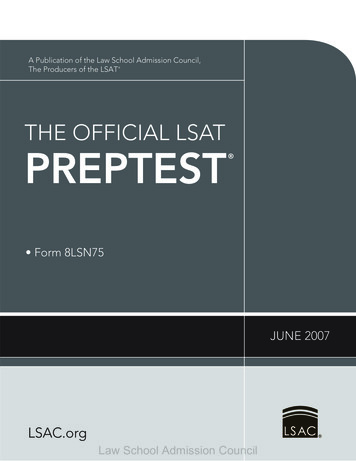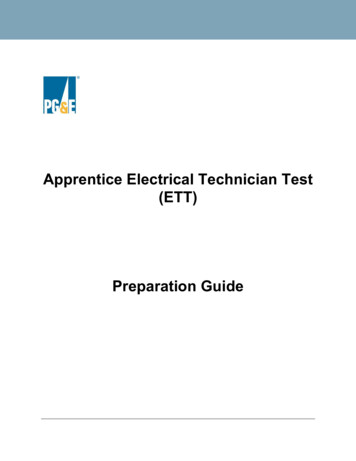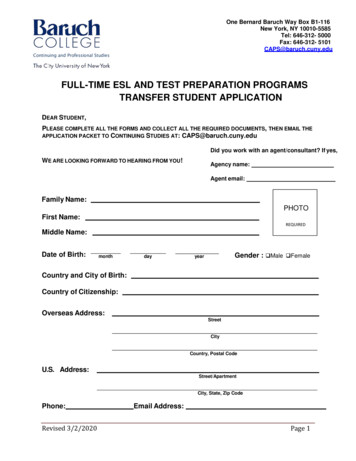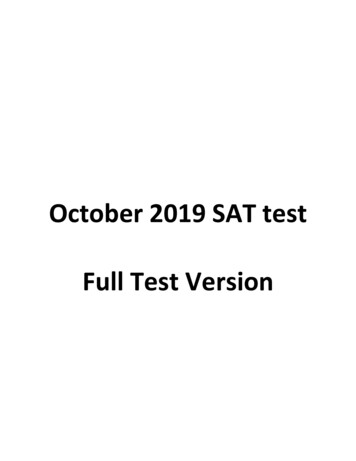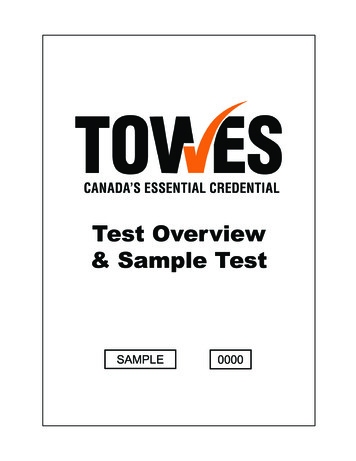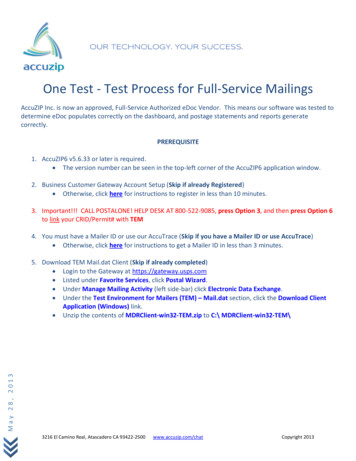
Transcription
LSATSELF-STUDY GUIDE1
THE POWERSCORE LSATSELF-STUDY GUIDESo, you’ve made the decision to prepare for the LSAT on your own. Good call! Thisguide will help you get started, identify the materials you need, and provide you with acomprehensive self-study plan.Let’s quickly outline the basic steps you need to take. If you have already completed anyof these steps, skip ahead to the next item on the list!TABLE OF CONTENTSTake a Practice LSAT. 3Analyze Your Results. 4Collect Study Materials. 6Set Up Your Study Plan. 8Stick to Your Study Plan. 10Review Your Progress, Make Changes as Needed. 10Take the LSAT and Destroy It!. 122
TAKE A PRACTICE LSATYour first step should be to take an actual, released LSAT and establish a baseline score. Takingan official digital LSAT will give you several benefits: You will become familiar with the types of questions presented on the exam and thelanguage patterns the test makers use. You will get a sense of the endurance and concentration required to complete the exam. You will get a starting score and a snapshot of where your strengths and weaknesses lie.Fortunately, you can get started with this process immediately, and for free! LSAC, thecompany that adminsters the LSAT, provides two free practice tests with the Official LSAT Prepprogram1. You should also take note of the LSAC Prep Plus subscription they offer. This will be akey purchase in your future study plans.HOW TO TAKE A PRACTICE TESTThere are a few things to note prior to taking an exam as well as important guidelines forproperly taking a practice test. There are 4 sections on an official LSAT test—1 Logical Reasoning, 1 Logic Games, 1Reading Comprehension, and 1 Experimental section that can be any of the abovesections. This section is unscored. Each section is 35 minutes long and there will be a 10 minute break following sectiontwo. This will require 2 hours and 30 minutes. During the test, you are allowed to work only on the section being timed. You cannot goback or forward to work on any other section of the test. Scratch paper can be used on the official test, so you may use scratch paper when youtake a practice test. There are certain things you can and cannot have on hand duringyour actual test administration, and you will want to simulate this when taking yourpractice tests. You can find a list of what you can and cannot have on hand in this blogpost2. You may not eat or drink during a timed section. Follow the guidelines rigidly and put in your best effort! The more realistic your results,the better decisions you can make later when setting up a study plan.No matter what your result, do not overemphasize the score you receive. You take an initial practiceLSAT to establish a baseline and to learn a little bit about how the test works. You should expect toimprove significantly over this first he-lsat/3
ANALYZE YOUR RESULTSOnce you complete your practice LSAT, your next important step is analyzing your results.LSAC’s platform automatically scores your test for you, but does not provide a breakdown ofyour performance. If you want a full analysis of each test you take, visit our free Self-Studysite1 and create a free student account. With your account, you can transfer your answersfrom any test into our scoring and analysis tool and receive a free statistical analysis of yourperformance.HOW TO ANALYZE YOUR RESULTSLSAC’s platform automatically scores your test for you, but does not provide a breakdown. Ifyou want a full analysis of each test you take, you have two options.1. Use our free Self Study site to transfer your answers into our free scoring tool.2. Look into adding our Testing and Analytics Package2 to your study arsenal. With thispackage, you receive every test LSAC provides as well as an automatic breakdown ofyour score upon completion of the test. In addition, you also get some flexibility withhow you take exams! With our package, you can take full practice tests, individualsections, and problem sets.SETTING A TARGET SCOREA “good” LSAT performance is, to some degree, relative to the range of schools you’reconsidering. If you want to go to Harvard, Berkeley, Michigan, etc, a good performance is inthe upper 160s and 170s. If you want to attend a top tier school, you need to go all-out for thehighest score possible! Every point counts, especially at the ultra-competitive top schools. Thisis also an excellent strategy even if you have a modest target law school. You may find that yourscore opens up so many new, attractice possibilities.In the end, it all comes down to doing your research. Determine what score is sufficient to gainadmission to the schools you’re interested in. While we believe that every student should shootfor a 180, it may be that you don’t need to put in the time required to get a score in the upperrange. Make sure you set your target score early in the process after seriously considering thetypes of schools you want to s/digital-tests/4
Once you have a general idea in mind for a target score, it’s time to look carefully at yourbaseline results. Take a look at the following areas and ask yourself some questions.1. How far away from your target are you?2. What’s your best section? Your weakest section? Identifying the weakest section willgive you a starting point for your studies.3. Within each section, what question types or game types gave you the most difficulty?Again, use this information to focus your studies when formulating a study plan.RECORD YOUR GOALSTarget Score:Baseline Score:Best Section:Weakest Section:Difficult Question Types:5
COLLECT STUDY MATERIALSThere are a variety of LSAT self-study materials available to students and they fall into threebasic categories.1. LSAT preparation guides containing strategies and techniques2. Practice LSATs or collections of individual questions.3. Question explanationsTo successfully self-prepare for the exam, having resources from all three categories can behelpful. Let’s discuss some of the available options.LSAT PREP GUIDESQuality LSAT study guides typically focus on individual sections of the LSAT. Depending on yourperformance in your baseline practice test, you should select guides for each area giving youdifficulty. For example, if Logic Games is your weakest section, look at guides that specialize inLogic Games. As far as individual books, we are of course partial to our well-known PowerScoreLSAT Bibles1. But, don’t take our word for it! We urge you to visit LSAT discussion forums andreviews on Amazon to see what others have to say.There are some book options where you can buy a book that attempts to explain all threesections of the test. We tend to be less impressed with these books because they usually covereach section very superficially. The LSAT is not an easy or suprficial test, and a book that coversthe entire LSAT in 400 pages or so cannot go into each section very ns/6
LSAT TESTS AND ANALYTICSAs you learn LSAT tips and techniques, you will need to practice with them extensively. The bestsource for practice materials are the LSAT PrepTests released by LSAC. LSAT PrepTests areauthentic, previously administered LSATs and they provide the closest approximation to theexam you will ultimately take. However, LSAC requires their Prep Plus suscription in order toaccess real digital LSATs and we strongly encourage pairing that subscription with our Testingand Analytics package. Let’s break down some of the benefits of doing so:1. You get every LSAT that has ever been released.2. Our platform automatically scores and analyzes the test for you. You will be able toeasily identify where your strengths and weaknesses lie.3. You can take full practice tests as well as individual sections for each released LSAT andproblem sets to help drill in the most difficult concepts.4. Your progress is automatically recorded so you can see how you’re doing, at a glance,from test to test.5. You can subscribe for monthly access or pre-pay for an entire year.QUESTION EXPLANATIONSAlthough any good study guide will explain the questions contained in the text, no studyguide explains questions not in the book. For that, you need to look for resources that containquestions and/or corresponding explanations. These are the best out there: The Official LSAT SuperPrep. This book contains three previously unreleased LSATs withcomplete explanations for each question from LSAC. Although they don’t always provideexplanations that clearly explain the correct strategy for attacking a question, readingthe explanations gives you a sense of how they think about the questions. Becauseunderstanding their mindset is critical to LSAT success, this is a book you should have inyour collection. The PowerScore LSAT Workbook Series. This series presents drills and questions for eachsection type, and then provides complete explanations for each problem. These aregreat tools if you want to practice with the techniques from each LSAT Bible and studyhow those strategies are applied to a variety of questions.7
SET UP A STUDY PLANOnce you’ve completed the basic steps outlined in this guide so far, your next step is to selecta study plan. To a great extent, your plan is affected by how much time you have until you takethe LSAT. For the most up to date information on when test dates and deadlines, go here1.Because the LSAT is not a test that lends itself well to cramming, the basic rule is this: the moretime you have to prepare, the better off you will be. So, if possible, start early!To make your LSAT preparation easier, we’ve created a set of free self-study plans that arebased on our LSAT Bibles. You can find these detailed plans on the free Self-Study site2.3 MONTHS2 MONTHS4 MONTHS6 MONTHS6 WEEKS12 MONTHS1 MONTHSTUDY PLAN OVERVIEWThe PowerScore Study Plans are extremely comprehensive and provide you with weekly plansand checklists. Select the plan that is closest to the amount of time before your LSAT and startpreparing!Each study plan uses the following pedagogical principles: First, you will learn the fundamentals of the LSAT and focus on the strategies andtechniques. The goal is to first learn how to best approach the LSAT. The more you knowabout the test and the best methods for solving questions, the better you score. You’ll then practice specific question types. You must regularly apply the methods youlearn in order to become as fast and efficient as possible. At designated intervals, you will take full practice tests. This is critical to becomingcomfortable on test day. One of the major problems test-takers face is fatigue.Frequently taking full practice exams acclimates you to the rigors of test core.com/self-study/8
Reviews of your practice sessions and test results are built in so you can trackimprovement and identify areas of difficulty. This portion of your preparation isessential. You must closely examine every question on each test you take. Understandwhy you answered questions incorrectly by asking where you went wrong and how canyou avoid missing questions like it in the future. Don’t neglect reviewing the questionsyou answered questions correctly, too! Could you have been faster or more certain? Use the results from your PTs to revise your general study plan to account for changesand improvements. As you progress, you will improve in some areas and find other areasthat still need work. If you keep running into issues with Logic Games, slant your studytime to allow for more games and review of more material about games. If you have aweakness, find it and work relentlessly to eliminate it.TIMING ON THE LSATOne question that frequently comes up concerns timing and using a timer while studying.Timing, while always important on the LSAT, should not be a primary concern for you whenyou begin your studies. One of the benefits of starting your studies early is so you don’t have toconcern yourself with timing out the gate.As you go through more material, however, you should begin to make timing a regular part ofyour preparation. For example, when you begin studying, you should keep an eye on the amountof time you take to complete each question, but you shouldn’t obsess over it. If you are takinglonger than desired, make note of that fact, but focus more on understanding the concepts inthe questions and the methods to solve them. Practice is not about starting at full speed; it’sabout understanding the fundamental steps and slowly working your way up to full speed.To keep things interesting while studying, you can use different timingstrategies such as timing yourself on a set of two or three questions andthen reviewing your performance. Or, you could time yourself on a setof five or ten questions and then go back and review each questioncarefully after you complete the set. The goal of timing yourself is foryou to gain a clear understanding of how fast you can move throughquestions as well as develop an internal clock that gives you a generalidea of your pacing.The farther you progress in your studies, the more frequently you should time yourself. Butremember, when you encounter a new concept (especially one that you find difficult), set asidethe timer until you are comfortable with the idea itself. Then start timing and tracking yourperformance again.9
STICK TO YOUR STUDY PLANGetting the materials together and selecting a study plan are the easy parts. Sticking to the planis much more difficult!When you set your schedule, do not generalize. Don’t say “I want to study a lot this week,” or “Iwant to take a practice test sometime.”Instead, be specific! “I want to study every day except Monday and Friday for at least 2 hours a day.” “I’m going to complete every item on the study plan this week by Friday.”Creating specific goals will help you stick to the schedule more easily and will give you anironclad guide for knowing whether or not you are following your plan.REVIEW YOUR PROGRESS,MAKE CHANGES AS NEEDEDIn war, the battle plan sometimes changes and adjustments have to be made as the campaigncontinues. The same holds true for your LSAT preparation. That’s right, taking on the LSAT is awar!At the outset, you may draw certain conclusions about your test performance or your studyschedule that subsequently change over time. Constantly revisit your progress and useyour practice test results1 to revise your estimations of needed study time and your areas ofstrengths and weaknesses.It’s also important to note that scheduling breaks is encouraged! Many test-takers avidlystudying for the LSAT experience burnout and score plateaus2. This is completely normal andoften times taking a break can help alleviate these issues and even increase your score3.What happens if you can’t keep up with your schedule? You have a few options.1. Postpone your LSAT date. Depending on when you are sitting for the LSAT, you mayhave the option of delaying your test while not losing out on the current applicationcycle4.2. Seek professional assistance from LSAT experts. If you feel that self-studying isn’t givingyou the results you want or if you feel you need a jump start to your studies, you have alot of options at your -law-school-to-ed-or-not-to-ed/10
RECOMMIT TO YOUR GOALSIf at any point you find yourself struggling and ready to go forward with option two, we offer anumber of different ways to help you get the score you want. Tutoring1. Private tutoring gives you the most personalized experience possible,allowing you to maximize your time and your score. A tutor will work around yourschedule, customize study plans to help you reach your specific goals, and tailorinstruction to your strenghts and weaknesses. We understand that tutoring is a biginvestment! That’s why you can schedule a free consultation with a tutor to discussexactly what we can do for you. Live Courses2. Our courses train you to take on the LSAT with comprehensivematerials and a personalized Online Student Center. When you enroll, you will takepart in over 70 hours of live lecture, gain access to exclusiveweekly LSAT Clinics, and have over 100 hours of supplementaldigital content at your fingertips. On Demand Course3. If you would prefer working throughlessons at your own pace, the on-demand version of our courseis the perfect option for you. Upon enrollment, you gain accessto 30 hours of pre-recorded lecture with Eric Ockert, an LSATexpert with over 11 years of teaching experience. In addition,over 55 hours of additional instruction is available to powerscore.com/lsat/courses/on-demand/11
TAKE THE LSAT & DESTROY IT!This is your ultimate goal, and if you are dedicated and diligent you can achieve it! Study hard,good luck, and remember that we’re here for you!FREE RESOURCES FROM POWERSCOREWe give away more free LSAT resources than any other LSAT company. Why do we do it?Because we hope you’ll see the very high quality of what we do, and then if you do choose totake a prep course, tutor, or buy a book, we’ll be in your thoughts. And if you don’t, that’s okaytoo! Maybe you’ll mention us to a friend. Let’s look at all the free LSAT help we offer. Free Webinars — Sign up to learn about important topics such as Conditional Reasoning,Causal Reasoning, Common Flaws, Basic Linear Games, and Templates in Logic Games,and many more. LSAT Discussion Forum — Dive into explanations for thousands of LSAT questions onour Forum. We also answer questions about LSAT methods, strategy, and preparation. Ifyou want answers, this is the place to be! LSAT Blog — Read articles about LSAT preparation, changes, news, test mentality, andlaw school admissions! We post content regularly. Equally valuable are the commentson each blog, where we offer our insights into specific questions from students. The PowerScore LSAT PodCast — Join world-class LSAT experts Dave Killoran and JonDenning as they make the LSAT feel fun. They cover developments in the LSAT worldand dive deep into important LSAT and admissions topics. PowerScore Free Help Area — Discover dozens of LSAT articles are available on ourFree Help site. We cover everything from LSAT basics to specifics of each section. Self-Study Site — Pick a study plan that works for you. We have 7 different plansavailable based on how much time you have until the test. And, when you take practiceLSATs, use our system for a full analytical breakdown. Twitter — If you are looking for breaking LSAT news, follow our CEO and author of theLSAT Bibles, Dave Killoran. And follow our main company account for regular updatesand special offers, PowerScore.If you ever have questions, want help, or need advice, can contact us at 1 (800) 545-1750 andLSAT@powerscore.com. Never hesitate to reach out!12
Copyright 2010-2021 by PowerScore Incorporated.All Rights Reserved. No part of this publication may be reproduced, stored in a retrieval system, ortransmitted in any form or by any means electronic, mechanical, photocopying, recording, scanning, orotherwise, without the prior written permission of the Publisher. Parts of this book have been previouslypublished in other PowerScore publications and on the powerscore.com website.LSAT, and PrepTest are a registered trademarks of the Law School Admission Council, Inc.PowerScore is a registered trademark. The LSAT Bible SeriesTM, The Logic Games BibleTM, The Games BibleTM, The LogicalReasoning BibleTM, The Reading Comprehension BibleTM, The Logic Games Bible WorkbookTM, The Logical Reasoning BibleWorkbookTM, The Reading Comprehension Bible WorkbookTM, are the exclusive service marked property of PowerScore. Anyuse of these terms or of these systems without the express written consent of PowerScore is prohibited.Published byPowerScore Publishing, a division of PowerScore IncorporatedCharleston, SCPublished in the United StatesAuthor: David M. Killoran08 10 20 2013
LSAT preparation guides containing strategies and techniques 2. Practice LSATs or collections of individual questions. 3. Question explanations To successfully self-prepare for the exam, having resources from all three categories can
